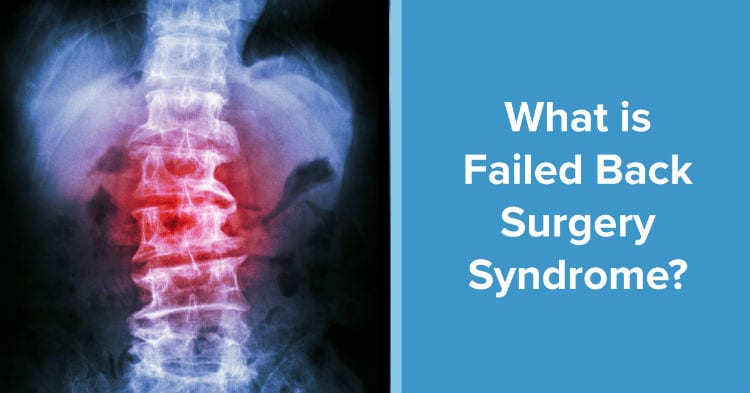Nearly 80 percent of Americans will experience back pain during their lifetime. Finding the cure for your back or neck pain can be a long journey, and for some, it ends with surgery. But what if you have neck or back surgery and continue to suffer from the same pain? Or worse, increased pain, tingling or numbness in new areas? You aren’t alone, and there is hope.
Failed back surgery syndrome is the medical term used to describe patients who continue to feel pain and discomfort after their neck, back or spine surgery. The pain or discomfort you feel may be the same as it was before you had your surgery, or different – perhaps an increased level of pain or discomfort, or pain or discomfort in a new area.
It’s important to note that while neck and back surgery are often viewed as the last resort to relieving your pain or discomfort, it is a process. Even in a perfect scenario, the actual operation itself is one step in the process. After surgery, your doctor should have a plan in place for rehabilitation. Often, it is through a combination of the surgery and your rehabilitation plan that relief is achieved.
Assuming that you’ve been through back surgery and completed (or are in the midst of) your rehabilitation plan and are still experiencing pain, you may be wondering, how can the surgery that was supposed to relieve you of your pain fail to do so?
There are a few different possible explanations – two of the most common are: you were misdiagnosed, and the lesion you had surgery on was not causing your pain; and the second explanation is that there is a second source of pain, in addition to the lesion on which you had surgery. There is also a third, less common reason, which involves the development of scar tissue after surgery. If you do have pain or discomfort as a result of scar tissue after surgery, you would only begin to notice the pain and discomfort 6 to 12 weeks post-operation – the amount of time it takes for scar tissue to form.
In addition to these reasons for pain, surgeries can fail due to a lack of experience and old techniques used by the surgeon. Unfortunately, even surgeons with experience often use traditional surgical tools and technologies, which prolong recovery times and put patients at a greater risk of having additional complications after the surgery is complete. The alternative to traditional tools and techniques is the advanced minimally invasive surgeries that are offered by some surgeons. In these procedures, cutting-edge tools are used, and incisions are small – usually less than one inch in diameter.
Failed Back Surgery Syndrome Symptoms
At first, it can be hard to tell whether or not you have symptoms of failed back surgery syndrome because as you recover from traditional back or spine surgery, some degree of pain and discomfort is expected during your recovery period. If you’ve communicated with your doctor about what you can expect after surgery when it comes to rehabilitation and level of pain and discomfort, you should have a better idea of what to expect. Therefore, if you have symptoms that aren’t what you expected, or linger longer than you anticipated, it will be easier for you to identify the symptoms of failed back surgery syndrome.
Despite its name, failed back surgery isn’t a syndrome at all – there are no standard symptoms. Just as everyone’s symptoms differ before back or spine surgery, failed back surgery symptoms also vary widely from patient to patient.
Some of the most common failed back surgery symptoms include:
- Return of your pre-surgery symptoms
- Inability to recover
- Consistent pain near the surgical site
- Pain and discomfort in other areas of the back or neck
- Back or neck cramps or spasms
- Limited mobility
- Tingling or numbness in your neck, back or other areas of the body
- Depression
- Anxiety
- Insomnia
While the physical symptoms are often what bring you back into the doctor’s office, and are the source of your frustration after surgery, it’s important to consider the mental and emotional toll failed back surgery syndrome can have on you. If you’re like many other back surgery patients, you’ve tried a variety of other conservative treatments, with back surgery being your last resort. When the result is the same, or new, pain as a result of your last resort treatment, it’s easy to begin to feel a sense of hopelessness immediately. Resorting to the perceived fact that your pain and discomfort are incurable is not the solution. The first step is a diagnosis.

Failed Back Surgery Syndrome Diagnosis
It’s easy to get frustrated at the return of your pre-surgery symptoms or even new symptoms as a result of the surgery that was supposed to ease your pain and discomfort, but the last thing you should do is resort to the fact that you have to live with these symptoms forever. Instead, you should be motivated to confirm whether or not you have failed back surgery syndrome so that you and your doctor can develop a plan to treat it. If you fail to get diagnosed, pain can continue to worsen and mobility can become more limited.
Diagnosis can be tough as a result of the normal levels of pain that come with invasive back surgery and recovery. One of the first steps to take if you’re experiencing pain after traditional back or neck surgery is to talk to your doctor about your rehabilitation plan. Everyone’s plan varies, but there should be a plan in place that encourages stretching, strengthening and conditioning as you heal.
Rehabilitation is crucial in recovering from back surgery and, over time, will relieve you of your pain and discomfort after surgery. If you continue to have pain and discomfort, despite having an adequate rehabilitation plan, failed back surgery syndrome may be the culprit.
The only way to know for sure is to make an appointment with a doctor who has experience in revision surgery to fix failed operations. At NJ Spine & Orthopedic, for example, our surgeons specialize in this type of treatment, and so chances are they’ve seen a patient that has had a surgery similar to yours that failed to address their neck or back pain and discomfort (or even made it worse). Once they’ve had the opportunity to learn more about your history, your surgery and your current symptoms, they can diagnose you – and more importantly, develop a treatment plan.
Failed Back Surgery Syndrome Treatment
There isn’t one treatment solution for failed back surgery syndrome, but there is one thing that remains the same for the overwhelming number of people who seek treatment – it takes time. Over time it’s easy to become more and more discouraged. However, giving up, as many patients with the early signs of depression may be tempted to do, is the worst thing you can do for your physical and mental health.

Begin With Conservative Treatments
We won’t hide the truth – at first, failed back surgery syndrome treatment options are going to involve a lot of the same, conservative treatments you went through before having back surgery. Some of the most common treatments include:
- Physical therapy
- Steroid injections
- Exercise (stretching, walking, swimming)
- Medication
- Massage
- Acupuncture
- Neck or back braces
Why would it work now, if it didn’t provide relief then? Because regardless of what type of back or neck surgery you had, your back is anatomically different than it was before surgery. Therefore, the treatment options will affect you differently.

Minimally Invasive Spine Surgery
If none of those treatments prove to be effective in the treatment of your failed back surgery syndrome, there is another option – minimally invasive spine surgery. Before you decide against having another back surgery, give us a chance to explain why not all back and neck surgeries are created equal.
Traditional back and neck surgeries often come with large incisions, through muscle, which results in blood loss and pain. Can you recover from a traditional back or neck surgery? Yes, and many people do, but it’s a surgery that requires time in the hospital and quite a bit of time off before you can get back to your normal level of activity. Minimally invasive spine surgical procedures are different. In place of the large incisions, you have small incisions, often the size of a nickel or dime. Due to the significant difference in the size of the incision, much less of your muscle is affected, and less blood is lost. This type of surgery is so radically different that you’re able to go home the same day as the procedure and the recovery time is also much less.
Now that you know a little bit more about this type of surgery let’s revisit the most common reasons for failed back surgery: misdiagnosis, a second source of pain or scar tissue or nerve damage. In all three of these cases, if conservative treatment options fail, minimally invasive spine surgery is likely to provide a solution. For a lesion that you had operated on that didn’t end up being the cause of your pain, your doctor goes through a diagnosis process to find the likely cause and can remove or replace it. If there’s a second source of pain, either one that has always existed or one that came as a result of your failed surgery, the same diagnosis process and use of minimally invasive surgery applies. In addition to being able to have this less involved surgical treatment option available to remove the cause of your pain and discomfort, you can also do it without having to worry about causing scar tissue and nerve damage that often comes with the large incisions involved in traditional surgery.
NJ Spine & Orthopedic
At NJ Spine & Orthopedic, our doctors have over 50 years of experience. They are innovators in the field of minimally invasive spine surgery and specialize in revision surgery to fix failed surgeries – a winning combination for someone who is desperately searching for treatment for failed back surgery syndrome. In addition to having the knowledge and experience, our doctors have compassion for the people they meet and want to do everything they can to help them.
While we’re recognized for being a surgical center, that doesn’t mean we jump right to surgery as the solution – but it does mean that in the worst-case scenario if other, conservative treatment options fail to relieve your symptoms, we have experience in revision surgery that’s hard to beat.
In addition to specializing in revision surgeries, our doctors only deliver minimally invasive laser spine surgeries. That means your surgery would be performed using state-of-the-art equipment and your recovery time would be significantly faster than traditional back surgery. This type of surgery also comes with a decreased risk of scar tissue, as the incisions are minimal and made with lasers instead of traditional surgical tools.

Most Common Failed Back Surgery Treatment Options
We treat people with a diverse range of failed neck and back treatments including herniated discs, disc degeneration, sciatica, pinched spinal nerves, scoliosis (or other spinal curvature issues), compression fractures from osteoporosis, accidental fractures and more. Two of the most common minimally invasive surgical procedures we do are:
- Failed Spinal Fusion Treatment – Herniated discs are painful. While many techniques can be attempted, often doctors will end up fusing the affected disc(s) together, which can provide initial relief. Unfortunately, combining two disc(s) into one limit mobility and affects the areas surrounding the fused disc, causing additional wear and pain. The solution is often an artificial disc replacement, one of the most advanced treatments for pain resulting from a failed neck surgery. Our doctors have a 98 percent success rate with this treatment option. In an artificial disc replacement, the disc that is causing you pain is removed and replaced with a man-made device. Since this procedure is minimally invasive and does not involve the fusion of discs, the typical result is a full range of motion and almost immediate, long-lasting pain relief.
- Failed Lumbar Laminectomy – Both spinal and foraminal stenosis can leave you with a long list of symptoms. If conservative treatment has failed to give you relief, many doctors will turn to a lumbar laminectomy, creating more space in the spinal cord cavity. Unfortunately, the use of outdated surgical procedures and a lack of experience can result in an unsuccessful surgery. Fortunately, one of our very own world-renowned surgeons, Dr. Scott Katzman, created an alternative procedure, known as a Laminoforaminotomy that is used in place of, or to revise, the traditional lumbar laminectomy. While the objective of creating more room for the spinal cord is the same, the advanced technique and cutting-edge tools used in this minimally invasive procedure leave you with incisions less than one-inch wide and no hospital stay. While shorter recovery time is a significant benefit, the lack of large incisions through muscle means less soreness and less chance of any scar tissue build up.
If you think you might be suffering from failed back surgery syndrome, contact us. Our online condition check tool gives you the opportunity to get feedback directly from one of our spine specialists by telling us more about your experience and your symptoms. If you already know you suffer from a failed back surgery, we have an online treatment check tool that is an excellent starting point for developing a plan of action to get your pain under control and to relieve you of it altogether.

